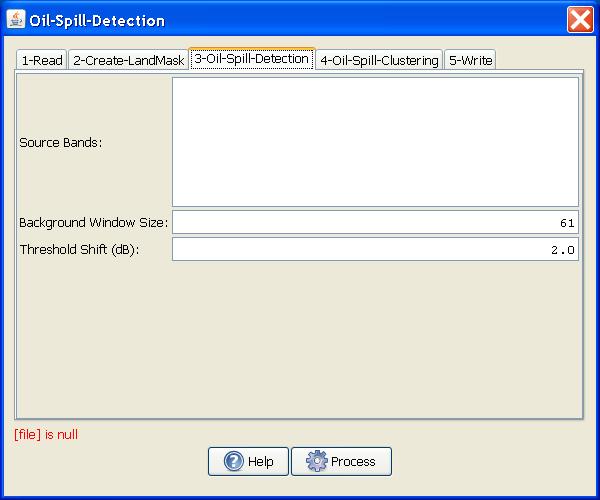Oil Spill Detection
The operator detects dark spot such as oil
spill on sea surface from SAR imagery.
Major Processing Steps
The oil spill detection operation consists of the
following four operations:
- Pre-processing:
Calibration and speckle filtering are applied to source image in
this step.
- Land-sea masking:
Land-sea mask is created in this step to ensure that detection is
focused only on area of interest.
- Dark spot detection:
Dark spots are detected in this step with an adaptive thresholding
method.
- Clustering and
discrimination: Pixels detected as part of the dark spot are
clustered and then eliminated based on the dimension of the cluster
and user selected minimum cluster size.
For details of calibration and speckle filtering
operations, the readers are referred to the
Calibration
operator and the
Speckle Filter
operator. Here it is assumed that the calibration and
speckle filtering have been performed before applying the oil spill
detection operator.
For details of land-sea mask generation, the
readers are referred to the
Create Land Mask
operator.
Adaptive Threshold Algorithm
The dark spots are detected using an adaptive
thresholding method.
- First the local mean backscatter level is estimated using
pixels in a large window.
- Then the detecting threshold is set k decibel below
the estimated local mean backscatter level. Pixels within the
window with values lower than the threshold are detected as dark
spot. k is a user selected parameter (see parameter Threshold Shift
below).
- Shift the window to next window position and repeat step 1 and
2.
Discrimination
- First the contiguous detected pixels are clustered into a
single cluster.
- Then clusters with their sizes smaller than user selected
Minimum Cluster Size are eliminated.
Visualize Detected Oil Spill
The oil spill detection bit mask is output as a separated band.
To view the oil spill detection results, the following steps
should be followed:
- Bring up the image.
- Go to Layer
Manager and add the oil spill bit mask band as a layer.
Parameters Used
For dark spot detection, the following parameters
are used (see figure 1):
- Source Bands: All bands (real or virtual) of the source
product. User can select one or more bands for producing
multi-looked images. If no bands are selected, then by default all
bands are selected.
- Background Window Size: The window size in pixels for computing
local mean backscatter level.
- Threshold Shift (dB): The detecting threshold is lower than the
local mean backscatter level by this amount.

Figure 1. Oil Spill Detection
Operator dialog box.
For clustering and discrimination, the following
parameters are used (see Figure 2):
- Minimum Cluster Size: The minimum cluster size in square
kilometer. Cluster with size smaller than this size is
eliminated.

Figure 2. Oil Spill Clustering
operator dialog box.
Reference:
[1] A. S. Solberg, C. Brekke and R. Solberg, "Algorithms for oil
spill detection in Radarsat and ENVISAT SAR images",
Geoscience and Remote Sensing Symposium, 2004. IGARSS '04.
Proceedings. 2004 IEEE International, 20-24 Sept. 2004, page
4909-4912, vol.7.



